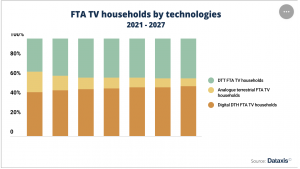
After more than 40 years of operation, DTVE is closing its doors and our website will no longer be updated daily. Thank you for all of your support.
Sub-Saharan Africa: slow progress on switchover
As South Africa grinds through towards completion of its protracted switchover to digital TV, Sub-Saharan Africa as a whole will continue to see slow growth of DTT homes through to 2027, with analogue broadcasting remaining on air in many countries, according to Dataxis.
 The research outfit predicts that the proportion of digital terrestrial households will increase from 38% today to 41% by 2027, with DTH remaining the mostly widely used TV distribution technology,
The research outfit predicts that the proportion of digital terrestrial households will increase from 38% today to 41% by 2027, with DTH remaining the mostly widely used TV distribution technology,
While government switchover programmes have stalled or progressed slowly, commercial broadcasters have used digital transmission to increase their reach with pay TV services. DTT accounts for 24% of direct pay TV hoes today, according to Dataxis.
The ITU originally agreed with 54 African countries that analogue TV should be switched off by 2015. However, currently DTT reaches 90% of homes in only 14 countries, set to rise only to 15 by 2027.
Dataxis points to multiple reasons for the delay. While most countries adopted the European DVB-T and DVB-T2 standards, some adopted the Chinese DTMB or the Japanese ISDB-T standard based on specific equipment partnerships struck by governments. This has led to fragmentation and limited possibilities for regional cooperation.
Larger countries faced large infrastructure bills, with limited incentives either for government to build the infrastructure or for consumers to purchase reception equipment. Misapplication of public funding also took its toll.
In some countries, premature switchover resulted in large numbers of people losing TV reception, as happened in Kenya in 2015, when 1.3 million homes lost reception.
Switchover is complete to date in Côte d’Ivoire, Burkina Faso, Gabon, Namibia, Botswana, Zambia, Rwanda, Tanzania, Kenya, Malawi and Eswatini.


